
You hear a lot of discussion about “green” building these days. And not just by environmentalists; some in the construction industry are “going green” to appeal to a growing number of homeowners concerned about making their homes healthy, as well as a place to conserve water and energy costs.
A recent McGraw-Hill Construction/National Association for Home Builders survey says that, by 2010, the value of the residential green building marketplace is expected to boost its market share to $19 billion-$38 billion and 5-10 percent of residential construction activity. That’s quite an increase from 2005, when green building had a market share of $7.4 billion and only 2 percent of housing starts.
However, there can be some conflict in the construction community about the cost-effectiveness of green building - creating a safer and cleaner indoor environment vs. the impact on the project schedule. A 2005 report by Air Quality Sciences Inc. says that a coordinated approach, planned for during the design phase and carried out through the life of the project, can alleviate this concern.
And while first costs are important, the real financial benefits to building green come during the life cycle of the building. Consider the cost efficiencies of using less water and less energy during a family’s lifetime in a home. The best way for your customers to see the benefits of green building is to think about the long-term payback.
One area of the home that has benefitted from the “green” trend is the bathroom. Many manufacturers in the decorative plumbing arena now are offering water-conserving fixtures, such as low-flow faucets, showerheads and toilets/water closets. True, some of these water-conserving products were mandated by law, but others strive to go that one step further.
But there is more to an environmentally friendly bathroom than the faucet, the showerhead or the toilet. During a mini-seminar at the 2006 Kitchen & Bath Industry Show, Nancy Christie of Smart Homeowner magazine shared ideas of how and where consumers can "green" their bathrooms.
How Low Can You Go?
The most obvious place forPMto start is with what we’re familiar with: water fixtures. And we’ve talked about water conservation in the pages of this magazine before. Consider this a refresher course.According to the American Water Works Association (www.awwa.org), total tap water use (indoor and outdoor) in a typical single-family home is 101 gallons per capita per day. Only 3 percent is used for drinking; the rest goes for bathroom uses, clothes washing, outdoor watering, etc.
In an average home, plumbing leaks account for about 14 percent of water consumed. And leaking toilets can waste from 30 to 500 gallons a day - that’s roughly $1,000 a year. Fixing leaky pipes and fixtures or, better yet, installing low-flow plumbing fixtures - toilets, faucets, showerheads - can significantly reduce water consumption.

Low-flow toilets
The biggest water savings in the bathroom come from installing low-flow toilets. Replacing an old 3.5-gallons per flush unit with a 1.6-gpf unit can cut in half the amount of gallons per person per day, while a dual-flush toilet can reduce that amount about two-thirds, according to H2Ouse (www.h2ouse.org), a virtual home created by the California Urban Water Conservation Council to help users find water-saving opportunities throughout their homes.Dual-flush means just that; there is one lever for liquid waste (half flush - 0.8 gpf) and a second lever for solid waste (full flush - 1.6 gpf). In one year, a dual-flush water closet can save more than 17,000 gallons of water for a family of four; a conventional 1.6-gpf unit can save more than 14,500 gallons of water.
What can we see in the future of low-flow toilets? Waterless urinals have been on the market for the past few years, but not really focused on the residential market - yet. There also are some ultra-low-flow toilets on the market that use 1.1 gallons per flush.
There are new toilets that have a small electric grinder in the trap, which grinds all solids and then uses a small amount of water to remove the waste.
A substantial amount of water is lost due to flapper leaks, so flapperless toilets may be the answer. Also, a national standard for the design and manufacture of toilet flapper valves could eliminate the current confusion surrounding the replacement of flapper valves.
And the Environmental Protection Agency has just launched its WaterSense program, alerting consumers as to which fixtures save the most water. At present, only high-efficiency toilets are included in the program.
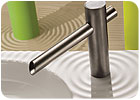
Low-flow faucets
Faucets with low-flow aerators can save that typical nuclear family more than 1,700 gallons of water each year; 1,300 gallons would be from reduction in hot water use. According to the Partnership for Advancing Technology in Housing (PATH) (www.pathnet.org), the new aerator technology compensates for pressure and provides the same flow regardless of pressure. They can cut water usage by as much as 40 percent.Another way to save water is to use the faucet less; don’t run water when you don’t need it. This is where electronic faucets come into the picture.
“Hands-free or touchless faucets are showing up in more and more homes, perhaps because they can provide dual benefits: They reduce the transference of germs by eliminating the need to touch the handle to operate the faucet, and they conserve water, which only flows when a hand or item such as a toothbrush triggers a sensor in the faucet,” Christie says. “Since running the tap wastes approximately 5 gallons of water per day, touchless faucets can really plug up the water leak.”
But these aren’t those institutional-type ones you’ve seen in public restrooms; manufacturers of residential hands-free faucets have married form with function to create faucets with beauty and personality that also conserve water.
New on the horizon are hands-free faucet controllers - a foot pedal controller and a “leaning” bar controller. The H2Ouse site says these controllers serve as on/off switches for the faucet. The foot pedal model is located on the floor, but may be difficult to install without disrupting cabinet and sink configurations.
The bar controller is more practical for residential use. It is installed underneath the sink counter; leaning into the bar starts the flow of water from the faucet, while moving away from the bar stops the water flow. The bar also has a locking feature to keep the water faucet flowing when needed.
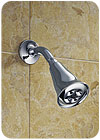
Low-flow showerheads
PATH says that low-flow showerheads use about 2.5 gallons of water per minute, compared to 4-5 gpm used by conventional showerheads. They use aerator technology similar to the low-flow faucets, as well as multiple flow settings, to save water.“But it isn’t enough to reduce water flow; homeowners still want to feel clean, and that means delivering the water with enough force to counterbalance the reduced flow,” Christie explains.
Plumbing manufacturers have answered that plea with several new products that manage water intensity and coverage to suit users’ preferences, yet still conserve water.
What about all those luxury shower systems on the market? The multiple showerhead, or spa shower, phenomenom should not “dramatically [influence] residential water use rates,” says H2Ouse.org. “Human biology and learned behavior governs showering frequency and that isn’t likely to change. These luxury showers are similar to giant Jacuzzi tubs or bidets and do result in additional water use for people who can afford to pay the bill.”
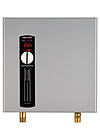
Energy-Saving Water Heaters
One product that Christie only touched on but that has seen some play in our industry is the tankless water heater - also known as on-demand water heater or instantaneous water heater.Heating water accounts for about 14 percent of the average U.S. household energy budget, PATH notes. Warmed water sitting in a tank creates standby losses. Tankless water heaters have, obviously, no tanks to store hot water; they can save 10 to 20 percent of a home’s energy bill, PATH says.
Tankless systems include whole-house systems and point-of-use systems, using electricity, gas or propane. A point-of-use model is ideal for a bathroom retrofit or an add-on room. The system’s heating device is activated by the flow of water; the heater then provides a constant supply of hot water until the water flow is shut off. Less water is wasted waiting for warm water to reach a remote faucet.
However, there are now tank-type water heaters on the market with very high thermal efficiencies, thus reducing energy costs. Homeowners, and contractors, should do their homework to find the right water heater for each situation. Correctly determining the hot water needs of the home will help in sizing and selecting the proper water heater.
What's Graywater Reuse?
A concept that plumbing contractors may not be familiar with is graywater reuse. Graywater is wastewater from bathtubs, shower drains, sinks, washing machines and dishwashers. It accounts for 60 percent of the outflow produced in homes, PATH notes. It contains little or no pathogens and 90 percent less nitrogen than black water (toilet water), so it does not require the same kind of water treatment process.Plumbing systems can be designed to separate graywater from black water, thus allowing it to be recycled for irrigation, toilets and exterior washing.
Systems generally consist of a three-way diverter valve, a treatment assembly such as a sand filter, a holding tank, a bilge pump, and an irrigation or leaching system. The holding tank cools the water and temporarily holds it back from the drain hose.
They are relatively easy to install in new construction if installed with DWV rough-in, PATH explains; a 2 1/2 bath home would require less than one half day of a plumber’s time and some drain pipe material. Retrofits should be assessed on a case-by-case basis.
The H2Ouse site explains that the future of this technology may lie in larger, utility-sponsored systems. “Many utilities are actively pursuing the option of collecting, treating and reusing graywater and delivering this water to customers via a dual-pipe network. The water is primarily used for irrigation at larger sites.”
Residential graywater systems have had mixed results, the site notes, and development is complicated by the fact that these systems are not legal in some cities and states. Consult your local plumbing code before designing and installing a graywater system.
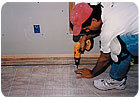
Warm Floors Can Save Energy, Too
Many pages of this magazine have been dedicated to this topic, and readers will not be surprised that radiant floor heat is considered a “green” technology. Since such a large area of the room is giving off heat, the floor temperature need only be 85 degrees F to provide comfortable heating, which saves energy. And because there is no air being blown through air ducts, those with allergies, asthma or other sensitivities can enjoy better indoor air quality.Radiant systems can be hydronic, where warm water is pumped through tubing installed beneath the floor, or electric, where cables, mesh, mats or films are used underneath the floor.
Electric radiant can be used as a primary source of heating or used to take the chill off a particular room. They are low wattage, about 10 to 15 watts per square foot.
“[A] plus for using electric radiant in remodels and retrofits is its method of installation,” notes the Radiant Panel Association’s Radiant Flooring Guide. “Many electric systems can be installed in a very thin thermal mass or mortar layer on top of a subfloor, with a minimal increase in finished floor height, a major advantage.”
Hydronic radiant heat is very versatile and can be used with many fuels and heat sources: natural gas, propane, electricity, oil, geothermal heat pumps or solar (see page 50 for information on solar heating systems). For the most energy efficiency, look for heat sources certified by the Environmental Protection Agency’s Energy Star program.
“[Hydronic radiant] can be designed as part of an integrated system that provides domestic hot water, heats a pool or spa, or includes other forms of hydronic heat such as hot water baseboards and radiators,” the RFG explains.
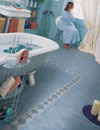
Green Floor Coverings
So what environmentally friendly flooring is available, and can it be used over radiant floor systems? Some of the green floor coverings listed in theRadiant Flooring Guideinclude:- Natural stone or ceramic tile.
- Concrete.
- Laminated flooring, vinyl or natural linoleum.
- Recycled rubber flooring.
- Wood certified from a well-managed forest, or sustainably managed bamboo.
- Recycled and recyclable carpeting or rugs, or those that have earned the Green Label certification for indoor air quality by the Carpet and Rug Institute.
Additional green flooring options recognized by PATH are:
Ventilation/Mold-Resistant Building Materials
Combating moisture buildup in the bathroom is essential to preventing mold growth and improving indoor air quality, Christie says. Bathroom fans provide effective ventilation, but homeowners should consider the noise level of the fan when in use, and the area it needs to ventilate.The noise level of ventilation fans is called the sone level. Research the products available - the smaller the sone level, the quieter the fan. Older fans may be at a 4-sone level, while newer fans may be less than 1 sone.
To size a fan, determine the cubic feet of the bathroom (width x length x height), multiply by eight (the desired number of air changes per hour), and divide by 60 (minutes per hour). This will give the cubic feet of air needed to exhaust per minute. The ventilation fan for that bathroom should meet or exceed that figure.
New models may be more energy-efficient, and include motion detectors and humidity sensors.
Mold growth requires moisture and a food source, PATH explains. And drywall has long been a convenient food source in humid climates or storm-ravaged buildings. (Remember the mold damage on the Gulf Coast after Hurricanes Katrina and Rita?) Manufacturers have now developed products with gypsum cores that will not absorb moisture as easily, have chemically treated the paper on both sides of the gypsum board, or eliminated the paper entirely by using glass mat facings or gypsum-cellulose combination.
Mold-resistant gypsum board and other materials are now available at many lumber yards. While mold-resistant does not mean that mold will not grow, these products limit the conditions that are prime for organism growth.
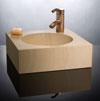
Low- Or No-VOC Paints
VOCs diminish air quality, and may be detrimental to homeowners’ health, especially those with allergies or sensitivity to chemicals.Most conventional paints contained high levels of VOCs that produced a breathable gas when applied.
Today, alternative manufacturing methods have allowed the development of low- or no-VOC paints that release no, or minimal, VOC pollutants, and are virtually odor-free, PATH notes. “Latex paints use water as their solvent and carrier, allowing both easier clean-up and generally lower toxicity than oil-based paints. [They] are equal or better in quality and durability than conventional oil-based formulas.”
Not every latex-based coating is low in VOCs, however, PATH says. Products may only be described as low VOC if they off-gas significantly less than other products. And some oil-based paints qualify as low VOC because their formulas have been modified.
Interior paint is given a Green Seal if it has a VOC content less than 50 grams per liter (for flat sheen) or 150 g/l (for nonflat sheen).
As noted earlier, there are low- or no-VOC adhesives for flooring, as well as stains and clear finishes for floors.
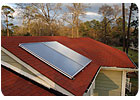
Sunny Forecast For Solar
by Steve Smith
The solar market is heating up thanks to rising energy prices, old-fashioned environmentalism and attractive tax cuts.The country that uses most of the world’s energy finally put its efforts behind a comprehensive renewable energy program as part of the Energy Policy Act of 2005, which took effect Jan. 1, 2006. Although many individual states already had tax breaks for solar, the new law also introduced a fed-eral solar tax credit, encouraging businesses and homeowners to put photovoltaic or PV panels on their roofs to generate electricity and to start using the sun to heat their water.
For the residential market, the credit amounts to 30 percent of the installation cost, but is capped at $2,000. There is no cap for commercial installations.
If some of this sounds familiar, it’s because Americans found themselves in the same circum-stances 30 years ago. In the 1970s, the energy crisis and environmental consciousness invigorated the solar industry. Federal and state tax credits, as well as utility rebates, didn’t hurt either. It was the first we heard about the “greening” of America.
However, the reputation of the solar industry suffered, as quick buck artists and unqualified deal-ers provided poorly installed, oversized and inadequate systems. Most solar thermal units sold back then, for example, weren’t much more complicated than a hollow box to trap heat.
“The skeletal remains of many of those Rube Goldberg systems are frightening to look at,” said a recent post about solar heat on The Wall.
When tax credits for solar expired in the 1980s, the American solar market expired, too. Accord-ing to the U.S. Census Bureau, solar thermal manufacturers in the United States declined from 225 in 1984 to 98 in 1986.
So is the U.S. solar market a sleeping giant ready to wake up, or will it just roll over for an extra nap if energy prices drop or tax cuts are eliminated?
“The market was growing even before the tax credits,” says David Sawchak of Schuco, a German company that makes both PV and thermal collectors. “While the credits certainly help, I think this time around solar can succeed based on its own value.”
The numbers back up the growth of the market. The American solar market for both PV and thermal has been steadily increasing since 2000 and particularly since 2003. For the sake of this re-port, let’s narrow the story down to just solar thermal collectors - equipment designed to provide domestic hot water or space heating. Any heating system requires electricity, but we’ll save the PV market for another time.
According to the U.S. Energy Information Administration, domestic shipments of solar thermal collectors increased 22 percent in 2004 compared to 2003. More than 13.3 million square feet of so-lar thermal equipment was installed in the United States in 2004.
Domestic shipment totals of solar thermal rose another 10.4 percent in 2005 to 14.7 million square feet, with Florida and California accounting for much of the American market at 34 percent and 26 percent market share, respectively. By contrast, the shipments were running half of this an-nual amount for much of the 1990s.
How do these figures compare outside our country? Germany may be the largest market for solar energy. In 2004, Germans installed 8 million square feet of solar thermal collectors - in other words, two-thirds as much capacity as the United States with a population one-third of the United States.
More Efficient: All right, so we have some work to do. In Europe, Sawchak says most of the solar industry’s advertising and marketing focus on “why our company is better than the other company.” With a much less developed market, Sawchak knows that American consumers need to be educated about the values of solar.
“The equipment is much more efficient today,” Sawchak adds. “That makes the payback for the initial installment costs that much faster and greater.”
That higher efficiency doesn’t just mean good things for individual homeowners, but also ex-pands the market for the equipment.
“We’re able to convert more of the sun’s radiation into heat,” says Joe Walsh of Oven-trop, a German radiant company that goes back to 1851. “That means we can offer solar energy in more parts of the country - parts that you might not consider ‘sunny.’ ” Today’s systems also are more sophisticated for storing solar energy, too.
Despite its cachet, solar energy contributes relatively little to the renewable energy total. Then again, not many people are able to build a hydroelectric dam in their backyards either.
Solar, therefore, represents the most practical renewable energy source. “Society as a whole is thinking more green,” Walsh adds. “The whole notion of LEED has made alternative energy seem a lot less alternative.”
Green Build Programs
The U.S. Green Building Council (www.usgbc.org) has developed a pilot program for the LEED for Homes Rating System. The new rating system builds on the existing LEED rating systems for commercial buildings, yet addresses the unique needs of the home building market. Launch of the LEED for Homes Rating System is expected this summer.The National Association of Home Builders also has a residential green building program called the NAHB Model Green Home Building Guidelines (www.toolbase.org/Home-Building-Topics/Green-Building/green-home-building-guidelines). One of the first homes rated under the new guidelines was developed by the NAHB Research Center and the Lancaster (Pa.) County Career and Technology Center as a field evaluation project for the Partnership for Advancing Technology in Housing. The home is scheduled to be completed this year.

